Jiaqi Zhu
Hunyuan-TurboS: Advancing Large Language Models through Mamba-Transformer Synergy and Adaptive Chain-of-Thought
May 21, 2025Abstract:As Large Language Models (LLMs) rapidly advance, we introduce Hunyuan-TurboS, a novel large hybrid Transformer-Mamba Mixture of Experts (MoE) model. It synergistically combines Mamba's long-sequence processing efficiency with Transformer's superior contextual understanding. Hunyuan-TurboS features an adaptive long-short chain-of-thought (CoT) mechanism, dynamically switching between rapid responses for simple queries and deep "thinking" modes for complex problems, optimizing computational resources. Architecturally, this 56B activated (560B total) parameter model employs 128 layers (Mamba2, Attention, FFN) with an innovative AMF/MF block pattern. Faster Mamba2 ensures linear complexity, Grouped-Query Attention minimizes KV cache, and FFNs use an MoE structure. Pre-trained on 16T high-quality tokens, it supports a 256K context length and is the first industry-deployed large-scale Mamba model. Our comprehensive post-training strategy enhances capabilities via Supervised Fine-Tuning (3M instructions), a novel Adaptive Long-short CoT Fusion method, Multi-round Deliberation Learning for iterative improvement, and a two-stage Large-scale Reinforcement Learning process targeting STEM and general instruction-following. Evaluations show strong performance: overall top 7 rank on LMSYS Chatbot Arena with a score of 1356, outperforming leading models like Gemini-2.0-Flash-001 (1352) and o4-mini-2025-04-16 (1345). TurboS also achieves an average of 77.9% across 23 automated benchmarks. Hunyuan-TurboS balances high performance and efficiency, offering substantial capabilities at lower inference costs than many reasoning models, establishing a new paradigm for efficient large-scale pre-trained models.
Representation Learning with Mutual Influence of Modalities for Node Classification in Multi-Modal Heterogeneous Networks
May 12, 2025Abstract:Nowadays, numerous online platforms can be described as multi-modal heterogeneous networks (MMHNs), such as Douban's movie networks and Amazon's product review networks. Accurately categorizing nodes within these networks is crucial for analyzing the corresponding entities, which requires effective representation learning on nodes. However, existing multi-modal fusion methods often adopt either early fusion strategies which may lose the unique characteristics of individual modalities, or late fusion approaches overlooking the cross-modal guidance in GNN-based information propagation. In this paper, we propose a novel model for node classification in MMHNs, named Heterogeneous Graph Neural Network with Inter-Modal Attention (HGNN-IMA). It learns node representations by capturing the mutual influence of multiple modalities during the information propagation process, within the framework of heterogeneous graph transformer. Specifically, a nested inter-modal attention mechanism is integrated into the inter-node attention to achieve adaptive multi-modal fusion, and modality alignment is also taken into account to encourage the propagation among nodes with consistent similarities across all modalities. Moreover, an attention loss is augmented to mitigate the impact of missing modalities. Extensive experiments validate the superiority of the model in the node classification task, providing an innovative view to handle multi-modal data, especially when accompanied with network structures.
In-Context Adaptation to Concept Drift for Learned Database Operations
May 07, 2025Abstract:Machine learning has demonstrated transformative potential for database operations, such as query optimization and in-database data analytics. However, dynamic database environments, characterized by frequent updates and evolving data distributions, introduce concept drift, which leads to performance degradation for learned models and limits their practical applicability. Addressing this challenge requires efficient frameworks capable of adapting to shifting concepts while minimizing the overhead of retraining or fine-tuning. In this paper, we propose FLAIR, an online adaptation framework that introduces a new paradigm called \textit{in-context adaptation} for learned database operations. FLAIR leverages the inherent property of data systems, i.e., immediate availability of execution results for predictions, to enable dynamic context construction. By formalizing adaptation as $f:(\mathbf{x} \,| \,\mathcal{C}_t) \to \mathbf{y}$, with $\mathcal{C}_t$ representing a dynamic context memory, FLAIR delivers predictions aligned with the current concept, eliminating the need for runtime parameter optimization. To achieve this, FLAIR integrates two key modules: a Task Featurization Module for encoding task-specific features into standardized representations, and a Dynamic Decision Engine, pre-trained via Bayesian meta-training, to adapt seamlessly using contextual information at runtime. Extensive experiments across key database tasks demonstrate that FLAIR outperforms state-of-the-art baselines, achieving up to 5.2x faster adaptation and reducing error by 22.5% for cardinality estimation.
Blissful (A)Ignorance: People form overly positive impressions of others based on their written messages, despite wide-scale adoption of Generative AI
Jan 26, 2025Abstract:As the use of Generative AI (GenAI) tools becomes more prevalent in interpersonal communication, understanding their impact on social perceptions is crucial. According to signaling theory, GenAI may undermine the credibility of social signals conveyed in writing, since it reduces the cost of writing and makes it hard to verify the authenticity of messages. Using a pre-registered large-scale online experiment (N = 647; Prolific), featuring scenarios in a range of communication contexts (personal vs. professional; close others vs. strangers), we explored how senders' use of GenAI influenced recipients' impressions of senders, both when GenAI use was known or uncertain. Consistent with past work, we found strong negative effects on social impressions when disclosing that a message was AI-generated, compared to when the same message was human-written. However, under the more realistic condition when potential GenAI use was not explicitly highlighted, recipients did not exhibit any skepticism towards senders, and these "uninformed" impressions were virtually indistinguishable from those of fully human-written messages. Even when we highlighted the potential (but uncertain) use of GenAI, recipients formed overly positive impressions. These results are especially striking given that 46% of our sample admitted having used such tools for writing messages, just within the past two weeks. Our findings put past work in a new light: While social judgments can be substantially affected when GenAI use is explicitly disclosed, this information may not be readily available in more realistic communication settings, making recipients blissfully ignorant about others' potential use of GenAI.
Hunyuan-Large: An Open-Source MoE Model with 52 Billion Activated Parameters by Tencent
Nov 05, 2024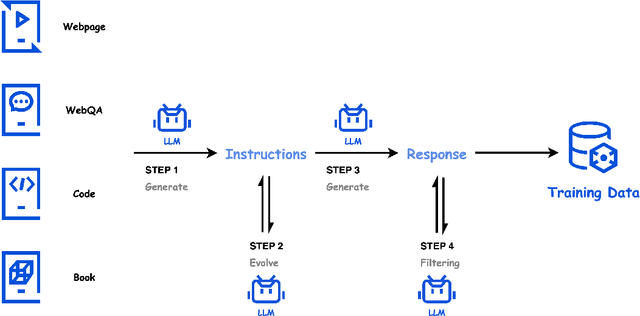
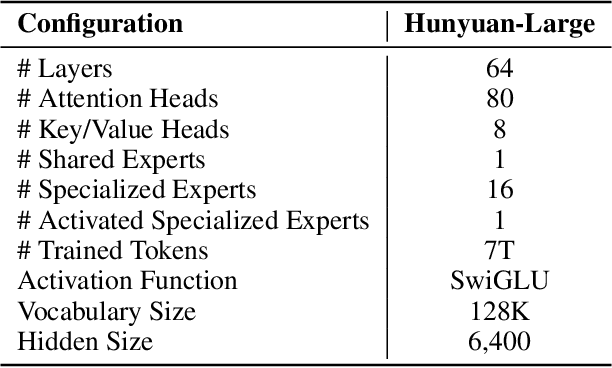
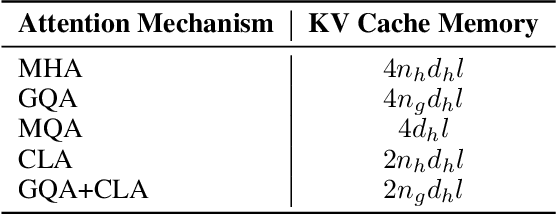
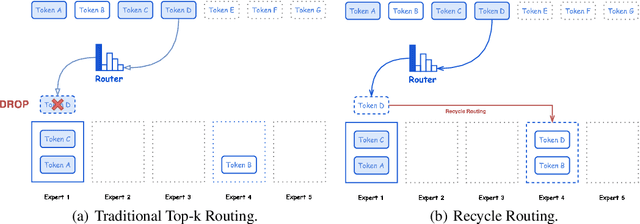
Abstract:In this paper, we introduce Hunyuan-Large, which is currently the largest open-source Transformer-based mixture of experts model, with a total of 389 billion parameters and 52 billion activation parameters, capable of handling up to 256K tokens. We conduct a thorough evaluation of Hunyuan-Large's superior performance across various benchmarks including language understanding and generation, logical reasoning, mathematical problem-solving, coding, long-context, and aggregated tasks, where it outperforms LLama3.1-70B and exhibits comparable performance when compared to the significantly larger LLama3.1-405B model. Key practice of Hunyuan-Large include large-scale synthetic data that is orders larger than in previous literature, a mixed expert routing strategy, a key-value cache compression technique, and an expert-specific learning rate strategy. Additionally, we also investigate the scaling laws and learning rate schedule of mixture of experts models, providing valuable insights and guidances for future model development and optimization. The code and checkpoints of Hunyuan-Large are released to facilitate future innovations and applications. Codes: https://github.com/Tencent/Hunyuan-Large Models: https://huggingface.co/tencent/Tencent-Hunyuan-Large
Flexible Diffusion Scopes with Parameterized Laplacian for Heterophilic Graph Learning
Sep 15, 2024



Abstract:The ability of Graph Neural Networks (GNNs) to capture long-range and global topology information is limited by the scope of conventional graph Laplacian, leading to unsatisfactory performance on some datasets, particularly on heterophilic graphs. To address this limitation, we propose a new class of parameterized Laplacian matrices, which provably offers more flexibility in controlling the diffusion distance between nodes than the conventional graph Laplacian, allowing long-range information to be adaptively captured through diffusion on graph. Specifically, we first prove that the diffusion distance and spectral distance on graph have an order-preserving relationship. With this result, we demonstrate that the parameterized Laplacian can accelerate the diffusion of long-range information, and the parameters in the Laplacian enable flexibility of the diffusion scopes. Based on the theoretical results, we propose topology-guided rewiring mechanism to capture helpful long-range neighborhood information for heterophilic graphs. With this mechanism and the new Laplacian, we propose two GNNs with flexible diffusion scopes: namely the Parameterized Diffusion based Graph Convolutional Networks (PD-GCN) and Graph Attention Networks (PD-GAT). Synthetic experiments reveal the high correlations between the parameters of the new Laplacian and the performance of parameterized GNNs under various graph homophily levels, which verifies that our new proposed GNNs indeed have the ability to adjust the parameters to adaptively capture the global information for different levels of heterophilic graphs. They also outperform the state-of-the-art (SOTA) models on 6 out of 7 real-world benchmark datasets, which further confirms their superiority.
Are Heterophily-Specific GNNs and Homophily Metrics Really Effective? Evaluation Pitfalls and New Benchmarks
Sep 09, 2024



Abstract:Over the past decade, Graph Neural Networks (GNNs) have achieved great success on machine learning tasks with relational data. However, recent studies have found that heterophily can cause significant performance degradation of GNNs, especially on node-level tasks. Numerous heterophilic benchmark datasets have been put forward to validate the efficacy of heterophily-specific GNNs and various homophily metrics have been designed to help people recognize these malignant datasets. Nevertheless, there still exist multiple pitfalls that severely hinder the proper evaluation of new models and metrics. In this paper, we point out three most serious pitfalls: 1) a lack of hyperparameter tuning; 2) insufficient model evaluation on the real challenging heterophilic datasets; 3) missing quantitative evaluation benchmark for homophily metrics on synthetic graphs. To overcome these challenges, we first train and fine-tune baseline models on $27$ most widely used benchmark datasets, categorize them into three distinct groups: malignant, benign and ambiguous heterophilic datasets, and identify the real challenging subsets of tasks. To our best knowledge, we are the first to propose such taxonomy. Then, we re-evaluate $10$ heterophily-specific state-of-the-arts (SOTA) GNNs with fine-tuned hyperparameters on different groups of heterophilic datasets. Based on the model performance, we reassess their effectiveness on addressing heterophily challenge. At last, we evaluate $11$ popular homophily metrics on synthetic graphs with three different generation approaches. To compare the metrics strictly, we propose the first quantitative evaluation method based on Fr\'echet distance.
HMoE: Heterogeneous Mixture of Experts for Language Modeling
Aug 20, 2024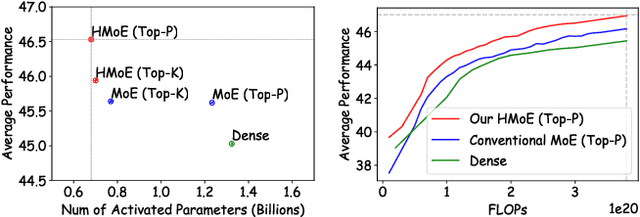



Abstract:Mixture of Experts (MoE) offers remarkable performance and computational efficiency by selectively activating subsets of model parameters. Traditionally, MoE models use homogeneous experts, each with identical capacity. However, varying complexity in input data necessitates experts with diverse capabilities, while homogeneous MoE hinders effective expert specialization and efficient parameter utilization. In this study, we propose a novel Heterogeneous Mixture of Experts (HMoE), where experts differ in size and thus possess diverse capacities. This heterogeneity allows for more specialized experts to handle varying token complexities more effectively. To address the imbalance in expert activation, we propose a novel training objective that encourages the frequent activation of smaller experts, enhancing computational efficiency and parameter utilization. Extensive experiments demonstrate that HMoE achieves lower loss with fewer activated parameters and outperforms conventional homogeneous MoE models on various pre-training evaluation benchmarks. Codes will be released upon acceptance.
Do LLMs Understand Visual Anomalies? Uncovering LLM Capabilities in Zero-shot Anomaly Detection
Apr 15, 2024Abstract:Large vision-language models (LVLMs) are markedly proficient in deriving visual representations guided by natural language. Recent explorations have utilized LVLMs to tackle zero-shot visual anomaly detection (VAD) challenges by pairing images with textual descriptions indicative of normal and abnormal conditions, referred to as anomaly prompts. However, existing approaches depend on static anomaly prompts that are prone to cross-semantic ambiguity, and prioritize global image-level representations over crucial local pixel-level image-to-text alignment that is necessary for accurate anomaly localization. In this paper, we present ALFA, a training-free approach designed to address these challenges via a unified model. We propose a run-time prompt adaptation strategy, which first generates informative anomaly prompts to leverage the capabilities of a large language model (LLM). This strategy is enhanced by a contextual scoring mechanism for per-image anomaly prompt adaptation and cross-semantic ambiguity mitigation. We further introduce a novel fine-grained aligner to fuse local pixel-level semantics for precise anomaly localization, by projecting the image-text alignment from global to local semantic spaces. Extensive evaluations on the challenging MVTec and VisA datasets confirm ALFA's effectiveness in harnessing the language potential for zero-shot VAD, achieving significant PRO improvements of 12.1% on MVTec AD and 8.9% on VisA compared to state-of-the-art zero-shot VAD approaches.
RulePrompt: Weakly Supervised Text Classification with Prompting PLMs and Self-Iterative Logical Rules
Mar 05, 2024



Abstract:Weakly supervised text classification (WSTC), also called zero-shot or dataless text classification, has attracted increasing attention due to its applicability in classifying a mass of texts within the dynamic and open Web environment, since it requires only a limited set of seed words (label names) for each category instead of labeled data. With the help of recently popular prompting Pre-trained Language Models (PLMs), many studies leveraged manually crafted and/or automatically identified verbalizers to estimate the likelihood of categories, but they failed to differentiate the effects of these category-indicative words, let alone capture their correlations and realize adaptive adjustments according to the unlabeled corpus. In this paper, in order to let the PLM effectively understand each category, we at first propose a novel form of rule-based knowledge using logical expressions to characterize the meanings of categories. Then, we develop a prompting PLM-based approach named RulePrompt for the WSTC task, consisting of a rule mining module and a rule-enhanced pseudo label generation module, plus a self-supervised fine-tuning module to make the PLM align with this task. Within this framework, the inaccurate pseudo labels assigned to texts and the imprecise logical rules associated with categories mutually enhance each other in an alternative manner. That establishes a self-iterative closed loop of knowledge (rule) acquisition and utilization, with seed words serving as the starting point. Extensive experiments validate the effectiveness and robustness of our approach, which markedly outperforms state-of-the-art weakly supervised methods. What is more, our approach yields interpretable category rules, proving its advantage in disambiguating easily-confused categories.
 Add to Chrome
Add to Chrome Add to Firefox
Add to Firefox Add to Edge
Add to Edge